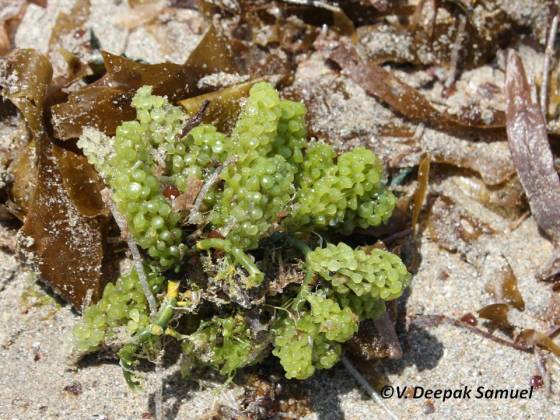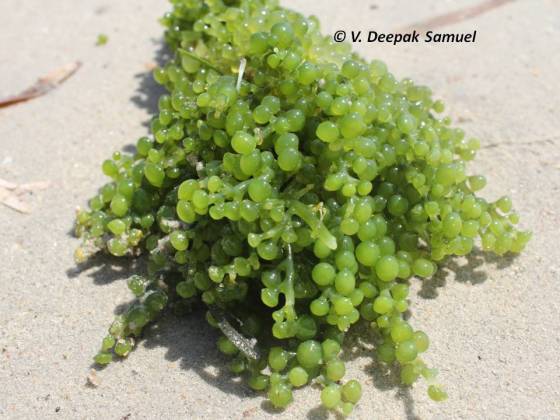Rightly named for its appearance as Oval sea grapes seaweed (Caulerpa racemosa), this macroalgae resembles a bunch of little grapes. The grape shape is bead-like, spherical or club shaped with rounded tips. The dense closely arranged grape-like structure makes it visually appealing. There are many species under this genus resembling Caulerpa racemosa (some are bell-shaped, umbrella shaped and rounded grape shaped). The oval sea grape possesses erect branches that arise from the horizontal stem at intervals of every few centimetres. Spherical structures arise from each erect branch and sometimes, closely arranged forming dense mats on sand, dead corals or other hard substrata. Small bunches may measure about 2-8 cm in length. They undergo vegetative propagation.
The oval sea grapes have a worldwide distribution inhabiting shallow waters like muddy bays to clear water reef environs growing up to depths of 100 m. Some reports point out the favourable conditions for Caulerpa species include clear water with weak to medium current patterns and loamy/ sandy bottom.
Caulerpa racemosa is eaten in countries like Philippines as fresh (salad) or preserved with salt (for increasing shelf life and eaten later). Japanese consume the sea grapes raw or fresh and so do people in Malaysia and Indonesia. Sea grapes are also given as livestock feeds in some countries. Caulerpa lentillifera, a species of sea grape is popularly called as green caviar.
Researchers have identified high levels of Caulerpin in tissues of omnivorous fishes that feed on certain species of sea grapes. Caulerpin is a toxin (Cytotoxin) varying in levels between species and is a fish repellent. In some species, Caulerpin is toxic when consumed to marine organisms or humans. Herbivorous fishes and sea urchins feed on the sea grapes voraciously. It is believed that these organisms prove to be efficient bio-control agents, keeping a check on the rapid growth of sea grapes.
A variety of sea grape species is considered as an alien invasive in the Mediterranean (Caulerpa racemosa var. cylindracea) since the 1990s. Even in Europe, Africa, Pacific coasts, Indian Ocean, the Carribean and in the Gulf of Mexico they have attained the alien invasive status. This has supposed to have suppressed the local microalgal community.
There are nearly 17 species of sea grapes recorded in the Indian waters. Information pertaining to this is available through literature documented by researchers. Besides these interesting facts, sea grapes found washed ashore or while snorkelling is truly a visual treat!
Taxonomic position
Kingdom: Plantae
Division: Chlorophyta
Class: Bryopsidophyceae
Order: Bryopsidales
Family: Caulerpaceae
Genus: Caulerpa
Species: racemosa
©V. Deepak Samuel



Really good information n nice photograph Dr. Deepak
thanks a lot Dr. Renitta.. keep reading!
Lovely note and snap shots …
Thanks Dr. Oz… do keep reading!
is it easy to differentiate between the toxic and non-toxic species of these algae?
Only scientists can do that Sheens.. I can identify a couple of species that is toxic found in Indian waters, but specialists can give the first hand info on non, less and highly toxic species…
Then when you say people eat these in certain countries, do they pick the non-toxic ones or are only the non-toxic ones prevalent in their regions anna?
yes Sheens! the non toxic species are easily identified by the natives..and indeed it is green caviar for them
Beautiful .. 🙂 I am so happy that you are enjoying your area of interest each and every day.
Thanks a lot Nandhini and do keep reading….
wonderful and colorful picture sir really your doing great job
Thanks a lot Peninanl.. keep reading!
Hats off Deepak…expect more from you lad
thanks a lot Raffi.. do keep reading…
Astonishing info sir …great work …is tat possible to publish our article in this site ….:)
Dear Umer, this is my personal site where i share my views and I invite guest articles for every 10 blogs I write and right now, an article from a conus specialist is on the pipeline but yes, I will take your article once my 18th blog is complete. This is a strict “ethical” procedure I adopt.. so just wait and I will let you know in a week’s time..
Keep reading!
Thanks you very much sir .